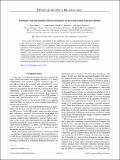Files in this item
Symbiotic and antagonistic disease dynamics on clustered networks using bond percolation
Item metadata
| dc.contributor.author | Mann, Peter Stephen | |
| dc.contributor.author | Smith, V.A. | |
| dc.contributor.author | Mitchell, John B. O. | |
| dc.contributor.author | Dobson, Simon Andrew | |
| dc.date.accessioned | 2021-08-04T16:30:09Z | |
| dc.date.available | 2021-08-04T16:30:09Z | |
| dc.date.issued | 2021-08-03 | |
| dc.identifier | 275040462 | |
| dc.identifier | 68f940d8-e913-4993-8597-bce2a6b49ca8 | |
| dc.identifier | 85112379273 | |
| dc.identifier | 000713696500003 | |
| dc.identifier.citation | Mann , P S , Smith , V A , Mitchell , J B O & Dobson , S A 2021 , ' Symbiotic and antagonistic disease dynamics on clustered networks using bond percolation ' , Physical Review. E, Statistical, nonlinear, and soft matter physics , vol. 104 , no. 2 , 024303 . https://doi.org/10.1103/PhysRevE.104.024303 | en |
| dc.identifier.issn | 1539-3755 | |
| dc.identifier.other | ORCID: /0000-0002-0379-6097/work/98196435 | |
| dc.identifier.other | ORCID: /0000-0002-0487-2469/work/98196639 | |
| dc.identifier.other | ORCID: /0000-0001-9633-2103/work/98196733 | |
| dc.identifier.uri | https://hdl.handle.net/10023/23717 | |
| dc.description.abstract | In this paper we introduce a description of the equilibrium state of a bond percolation process on random graphs using the exact method of generating functions. This allows us to find the expected size of the giant connected component (GCC) of two sequential bond percolation processes in which the bond occupancy probability of the second process is modulated (increased or decreased) by a node being inside or outside of the GCC created by the first process. In the context of epidemic spreading this amounts to both an antagonistic partial immunity and a synergistic partial coinfection interaction between the two sequential diseases. We examine configuration model networks with tunable clustering. We find that the emergent evolutionary behavior of the second strain is highly dependent on the details of the coupling between the strains. Contact clustering generally reduces the outbreak size of the second strain relative to unclustered topologies; however, positive assortativity induced by clustered contacts inverts this conclusion for highly transmissible disease dynamics. | |
| dc.format.extent | 9 | |
| dc.format.extent | 1004054 | |
| dc.language.iso | eng | |
| dc.relation.ispartof | Physical Review. E, Statistical, nonlinear, and soft matter physics | en |
| dc.subject | Complex networks | en |
| dc.subject | Percolation theory | en |
| dc.subject | Epidemic spreading | en |
| dc.subject | Coinfection | en |
| dc.subject | Clustered networks | en |
| dc.subject | QA75 Electronic computers. Computer science | en |
| dc.subject | RA0421 Public health. Hygiene. Preventive Medicine | en |
| dc.subject | T-NDAS | en |
| dc.subject | SDG 3 - Good Health and Well-being | en |
| dc.subject.lcc | QA75 | en |
| dc.subject.lcc | RA0421 | en |
| dc.title | Symbiotic and antagonistic disease dynamics on clustered networks using bond percolation | en |
| dc.type | Journal article | en |
| dc.contributor.institution | University of St Andrews. School of Chemistry | en |
| dc.contributor.institution | University of St Andrews. Office of the Principal | en |
| dc.contributor.institution | University of St Andrews. St Andrews Centre for Exoplanet Science | en |
| dc.contributor.institution | University of St Andrews. Centre for Biological Diversity | en |
| dc.contributor.institution | University of St Andrews. Scottish Oceans Institute | en |
| dc.contributor.institution | University of St Andrews. Institute of Behavioural and Neural Sciences | en |
| dc.contributor.institution | University of St Andrews. School of Biology | en |
| dc.contributor.institution | University of St Andrews. St Andrews Bioinformatics Unit | en |
| dc.contributor.institution | University of St Andrews. EaSTCHEM | en |
| dc.contributor.institution | University of St Andrews. Biomedical Sciences Research Complex | en |
| dc.contributor.institution | University of St Andrews. School of Computer Science | en |
| dc.contributor.institution | University of St Andrews. Sir James Mackenzie Institute for Early Diagnosis | en |
| dc.identifier.doi | https://doi.org/10.1103/PhysRevE.104.024303 | |
| dc.description.status | Peer reviewed | en |
This item appears in the following Collection(s)
Items in the St Andrews Research Repository are protected by copyright, with all rights reserved, unless otherwise indicated.

